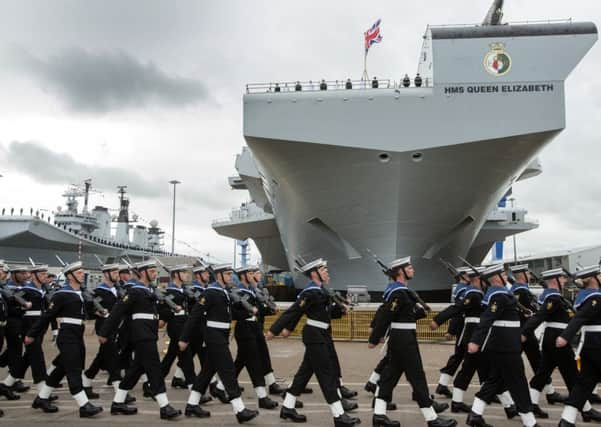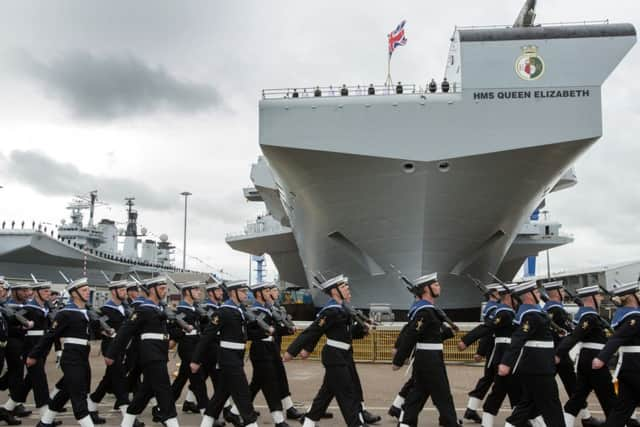HMS Queen Elizabeth leaves Rosyth dry dock


The dry dock holding the 65,000-tonne aircraft carrier HMS Queen Elizabeth was flooded to allow the vessel to be manoeuvred free and berthed at a nearby jetty in a three-hour operation yesterday.
Teams will now continue to fit out the ship and prepare her for sea trials in 2016. The journey downriver will involve her mast being lowered into a horizontal position to enable the massive vessel to slip under the Forth Bridge at low tide.
Advertisement
Hide AdAdvertisement
Hide AdEarlier this month, the ship was formally named by the Queen in a ceremony at the Rosyth Dockyard where she was assembled.


The ship, and a second vessel, the under-construction HMS Prince of Wales, are the biggest to be built for the Royal Navy.
The two ships are known as Queen Elizabeth class aircraft carriers and are being built by the Aircraft Carrier Alliance, a partnership of BAE Systems, Babcock, Thales and the Ministry of Defence.
The vacated dock will be used for the assembly of the Prince of Wales, which is set to begin in September.
Those behind the project, costing an estimated £6.2 billion overall, say the ships will be the centrepiece of Britain’s naval capability.
Jon Pearson, Queen Elizabeth delivery director at the Aircraft Carrier Alliance, said: “This is a vessel of unprecedented scale so floating her for the first time is a fantastic feat of engineering.
“The teams across the alliance are incredibly proud to have successfully reached this major milestone in the delivery of HMS Queen Elizabeth.
“Outfitting will now continue on the ship as we steadily bring her systems to life for the first time ahead of her sea trials.”
Advertisement
Hide AdAdvertisement
Hide AdHMS Queen Elizabeth has 17 decks stretching 72 metres from keel to mast. There are more than 3,000 compartments. She can cover up to 500 miles a day and has a range of 10,000 nautical miles.
The two carriers are planned to be in service for 50 years.
Each carrier will effectively provide the armed forces with a four-acre military operating base, which can be deployed worldwide, operating F-35 Lightning II jets and a number of types of helicopter.
Meanwhile, the helicopter carrier HMS Illustrious was set to leave the River Forth for the final time last night as she heads for her home port of Portsmouth.
After a career spanning three decades, the Royal Navy’s helicopter and command platform is being withdrawn from service.
Fleet Commander, Vice Admiral Sir Philip Jones, said: “HMS Illustrious has a long and proud history with the Royal Navy.
“During her 32 years of service she has protected our nation’s interests in the Falklands, Bosnia, Iraq, Sierra Leone and most recently the Philippines.
“The decision to replace her in service with HMS Ocean will ensure that the Royal Navy has her most advanced and capable ships working to protect the nation.
“It was only fitting therefore that HMS Illustrious’ final high-profile public role was to support the naming by Her Majesty of the Royal Navy’s new aircraft carrier HMS Queen Elizabeth on 4 July.
Advertisement
Hide AdAdvertisement
Hide Ad“Poignantly the ceremony allowed us to celebrate the navy we have known so well for so long with the navy of the future, side by side.
“The Royal Navy will of course mark the departure of HMS Illustrious with all the pride she deserves and is supportive of plans to retain her intact in the UK to preserve the legacy of the Invincible class and all those who served in them.”